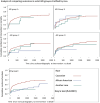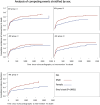Living in disadvantaged neighborhoods linked to less intervention for severe aortic stenosis
- PMID: 38418864
- PMCID: PMC10902341
- DOI: 10.1038/s41598-024-52660-w
Living in disadvantaged neighborhoods linked to less intervention for severe aortic stenosis
Abstract
To investigate the association between area deprivation index (ADI) and aortic valve replacement (AVR) in patients with severe aortic stenosis (AS). Patients aged 40-95 years with severe AS confirmed by echocardiography were included. The 9-digit zip code of patient residence address was used to identify the ADI ranking, based on which patients were divided into 5 groups (with Group E being most deprived). The rates of AV intervention were compared among 5 groups using competing risks analysis, with death as a competing event. We included 1751 patients with severe AS from 2013 to 2018 followed for a median 2.8 (interquartile range, 1.5-4.8) years. The more distressed ADI groups tended to be younger (P = 0.002), female (P < 0.001), and of African American race (P < 0.001), have higher presentation of sepsis (P = 0.031), arrhythmia (P = 0.022), less likely to have previous diagnosis of AS (P < 0.001); and were less likely to undergo AVR (52.5% vs 46.9% vs 46.1% vs 48.9% vs 39.7%, P = 0.023). Using competing risk analysis, the highest ADI group (E) were the least and the lowest ADI group (A) the most likely to undergo AVR (Gray's test, P = 0.025). The association between ADI ranking and AVR rates was influenced by sex and race. Within group analysis, there was significant association between race and AVR (Gray's test, P < 0.001), and between sex and AVR (Gray's test, P < 0.001). Patients with severe AS living in more deprived neighborhoods were less likely to undergo aortic valve interventions, which was influenced by female gender, and African American race.
© 2024. The Author(s).
Conflict of interest statement
The authors declare no competing interests.
Figures




Similar articles
-
Exercise Hemodynamics After Aortic Valve Replacement for Severe Aortic Stenosis.J Am Soc Echocardiogr. 2018 Oct;31(10):1091-1100. doi: 10.1016/j.echo.2018.07.001. Epub 2018 Aug 22. J Am Soc Echocardiogr. 2018. PMID: 30143436
-
Mitral annular calcification in patients undergoing aortic valve replacement for aortic valve stenosis.Heart Vessels. 2016 Feb;31(2):183-8. doi: 10.1007/s00380-014-0585-5. Epub 2014 Sep 25. Heart Vessels. 2016. PMID: 25252778
-
Incremental Prognostic Use of Left Ventricular Global Longitudinal Strain in Asymptomatic/Minimally Symptomatic Patients With Severe Bioprosthetic Aortic Stenosis Undergoing Redo Aortic Valve Replacement.Circ Cardiovasc Imaging. 2017 Jun;10(6):e005942. doi: 10.1161/CIRCIMAGING.116.005942. Circ Cardiovasc Imaging. 2017. PMID: 28559420
-
Meta-analysis of the impact of intervention versus symptom-driven management in asymptomatic severe aortic stenosis.Heart. 2017 Feb 15;103(4):268-272. doi: 10.1136/heartjnl-2016-309830. Epub 2016 Aug 18. Heart. 2017. PMID: 27540178 Review.
-
Latent myopathy is more pronounced in patients with low flow versus normal flow aortic stenosis with normal left ventricular ejection fraction who are undergoing surgical aortic valve replacement: Multicenter study with a brief review of the literature.Echocardiography. 2018 May;35(5):611-620. doi: 10.1111/echo.13839. Epub 2018 Apr 1. Echocardiography. 2018. PMID: 29605969 Review.
Cited by
-
Differential Characteristics and Outcomes of Urgent/Emergent Versus Elective Aortic Valve Replacement.J Am Heart Assoc. 2025 Jun 3;14(11):e041148. doi: 10.1161/JAHA.125.041148. Epub 2025 May 29. J Am Heart Assoc. 2025. PMID: 40439170 Free PMC article.
References
MeSH terms
Grants and funding
LinkOut - more resources
Full Text Sources
Research Materials

